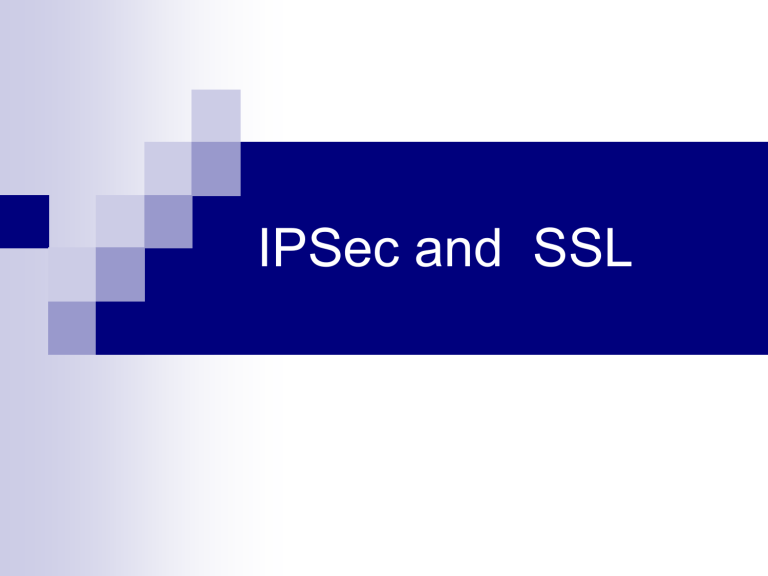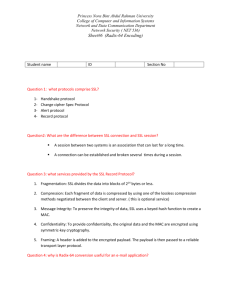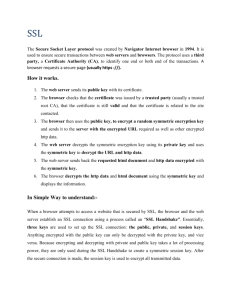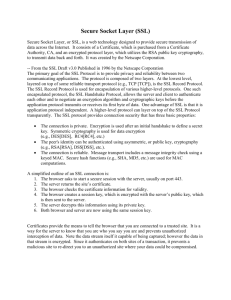IPSec and SSL

IPSec and SSL
Protocol Stack at Outset
• What we have to start with
HTTP FTP SMTP
TCP
IP
• Can be at just about any point
Where can we put security?
HTTP FTP SMTP
TCP
AH ESP
IP
Network approach
S-HTTP S/MIME
TCP
IP
Application approach
HTTP FTP SMTP
SSL/PCT/TLS
TCP
IP
Transport approach
SET PGP
HTTP FTP SMTP
TCP
IP
Presentation approach
IPSec - Network Approach
Sponsored by IETF
IPSec working group
Scheduled to be integral component of IPv6
Supports strong authentication and encryption at layer 3
Bi-directional tunnel
Packet filtering is primary access control method
Requires Public Key
Infrastructure (PKI)
IP Layer Security
• Functionality
– AH (Authentication Header): integrity and authenticity
– ESP (Encrypted Security Payload): confidentiality, optional authentication
& integrity
• Security Association (for each pair of hosts): determined by destination IP address and the SPI (Security Parameters Index)
– Specification of the crypto methods to be used by SPI
– Keys to be used by the crypto methods for that SPI
– The hosts and other entities associated with this traffic
• Key Management
– Manual Keying (required)
– Key Management Protocols (in flux)
IPSec AH Packet Format
IPv4 AH Packet Format
IPv4 Header Authentication Header Higher Level
Protocol Data
IPv6 AH Packet Format
IPv6 Header
Hop-by-Hop
Routing
Authentication
Header
Other Headers
Higher Level
Protocol Data
IPv6 AH Header Format
Next Header Length
Security Parameters Index
Reserved
Authentication Data (variable number of 32-bit words)
IPSec Authentication
• SPI: identifies the security association to use for this packet
– type of crypto checksum, how large it is, and how it is computed
• authentication data
– hash of packet contents include IP header as as specified by the transform indicated by the SPI
– treat fields which change hop-by-hop (TTL, header checksum) as zero
• Keyed MD5 Hash is default
MD5 Hash
Secret
Key
Key Headers and data being sent Key
IPSec ESP Packet Format
IPv4 ESP Packet Format
Unencrypted
IP Header
Other IP
Headers
ESP Header
Encrypted
Encrypted Data
ESP Header Format
Security Association Identifier
Opaque Transform Data, variable length
DES + MD5 ESP Format
Security Parameters Index (SPI)
Initialization Vector (optional)
Replay Prevention Field (incrementing count)
Payload Data (with padding)
Authentication checksum
IPSec Encryption
• ESP Modes
– Tunnel-mode: payload in a whole IP datagram, mobile-IP
– Transport Mode: payload is a higher level IP protocol, e.g., TCP/UDP
• DES with CBC is default
• Key Management
* ISAMKP/Oakley (mandatory)
–
ISAMKP - association management protocol
– Oakley - key management
– exchange message(s) to establish long-lived context
* Simple Key-Management for Internet Protocols -SKIP (elective)
Header Usage and Security
• IPSec standards recommend using the AH to protect the ESP
– AH validates both the IP addresses and the message contents
• Omitting the ESP
– without the ESP, it is possible to eavesdrop on the authenticated data
(this is a threat when resusable, secret passwords are used)
• Omitting the AH
–ESP does not generally protect against modification
– ESP is vulnerable to header cut-and-paste attack
• attacker takes out the ESP out of packets and inserts a new ESP destined for another machine (when IPSec proxy is used)
• another solution is to assign unique security associations to different pairs of communicating hosts (burden on administrators)
IPSec Issues
Benefits:
Integrated directly into IP stack
Uses public key technology
Proposed IETF standard
Security model for IPv6
Supports strong authentication and encryption mechanisms
Expected to be widely deployed in internetworking devices
Supports only IP traffic
Concerns:
IETF working group slow to establish consensus
Client deployment dependent on Microsoft
Competing key management standards
Requirement for public key infrastructure
Router Vendors are central to deployment
Users vs Addresses
Transport Approach - SSL/TLS
• SSL:
S ecure S ockets L ayer TLS: T ransport L ayer S ecurity
• SSL Version 1: Was quickly replaced by SSL v2. Not in use today.
• SSL Version 2: Has some security problems. Still supported.
• PCT: Microsoft’s response to SSL 2.0. Fixes some problems, but has been supplanted by SSL 3.0.
• SSL Version 3: Complete redesign of SSL. Fixed the problems in previous versions and added many features
• TLS: Under development IETF standard based on SSL 3.0 with enhancements.
What problem does SSL Solve?
• Allows secure communications between two computers, provided that at least one has a certificate trusted by the other (avoids manin-the-middle when possible).
• Isolates application developers from the complexities and dangers of cryptosystem design.
• Supports authentication, encryption, and key exchange
• Reliable connections via various secure hash functions
• Efficient, extendible, easy to integrate, not ASN.1 based, secure, open, interoperable.
• End-to-end armored pipe only, not signed letter and sealed envelope model.
A simple SSL-like protocol
Problem : A user wants to shop at a merchant’s server -- but the server doesn’t know anything about the user.
Phase 1 : Handshake to produce a shared secret K.
1 . User requests, obtains, and verifies Server’s certificate
2. User creates a 160-bit value K at random
3. User computes K encrypted with server’s public key and sends the result to S.
4. Server decrypts with its private key to recover K.
5. Server hashes K and sends the result to user.
6. User also hashes K and verifies the value from server.
Simple SSL-like protocol, cont
Phase 2 : Secure communications using a shared secret K.
Data to be exchanged is broken into packets.
• Prior to transmission, each packet of data is encrypted and
MAC’ed (Message Authentication Coded):
– Communications are encrypted using K to ensure that data are private from eavesdropping
– Communications are MAC’ed using K to ensure that data are secure against tampering and modification
• The recipient decrypts the packet and verifies the MAC. An incorrect MAC indicates a fatal error.
SSL Protocols
• The handshake Protocol: negotiates the use of new crypto algorithms and keys.
• The record protocol: functions as a layer beneath all SSL messages and indicates the encryption and integrity protection being applied to the data.
• The alert protocol: when errors have occurred or when a session is being ended.
SSL Handshake: Protocol
• Handshake Protocol Goals:
– Negotiate security parameters,
– Authenticate server to client (server name must match name in certificate to prevent man-in-the-middle attacks)
– Authenticate client to server (if requested by server),
– Create a secret (the “Master Secret” shared between the participants)
• Negotiated protocol parameters
– Protocol version (e.g., SSL 3.0, TLS 3.1, etc.)
– CipherSuite (crypto algorithms, etc. )
– Compression method (e.g., none)
SSL Handshake: CipherSuite
• The CipherSuite defines the cryptographic algorithms, key sizes, etc
• CipherSuite Parameters:
– Encryption Algorithm: none, RC4-40, RC4-128, RC2-40, IDEA-128,
DES-40, DES, TripleDES
– Public Key algorithm: RSA, Fortezza, or Diffie-Hellman (with RSA,
DSS, or, no certificates* )
– Hash Function: MD5, SHA
* Certificate-less handshakes are vulnerable to man-in-the-middle attacks. In some environments, anonymous Diffie-Hellman is helpful -- but in most cases, any support for anonymous ciphersuites would be a massive security flaw
Client
MasterSecret
Server’s Public
Key
Server
SSL Handshake: Steps
1. Client sends ClientHello message.
2. Server acknowledges with ServerHello message.
3. Server sends its certificate.
4. Server requests client’s certificate
Server Certificate
5. Client sends its certificate.
6. Client sends ClientKeyExchange message
7. Client sends a Certificate Verify message.
8. Both send ChangeCipherSpec messages.
9. Both send Finished messages.
Server’s
Private Key
SSL Handshake:Resuming Sessions
• Goal: minimize the number of SSL handshakes since:
– Private key operations take server time
– Network round trips are slow (2 per handshake)
• If two parties have recently communicated, they already have a shared master. If both parties agree, the old master secret can be reused. This is called resuming a session.
• A Hack: Adding state to a stateless protocol (http)
• Resuming can be done even if the parent session is still alive to split sessions (e.g., to have 4 simultaneous connections, do the handshake once then “resume” three new sessions).
SSL Record Layer
• Defines how application data (payload) is:
– broken into packets
– encrypted and decrypted
– MAC’ed and verified
• Record Layers:
– SSL Plaintext - type, SSL version, length, data
– SSL compressed compressed (SSL plaintext)
– SSL Ciphertext - encrypted
(MAC and SSLcompressed)
SSL ciphertext
MAC Content Padding
SSL compressed
SSL Plaintext
Real application data
• Four keys are used and derived from the MasterSecret:
– Server write key
– Client write key
– Server write MAC secret
– Client write MAC secret
Strengths of the SSL
• Bruteforce Attack
– 128 bits or more can be said to be safe in the foreseeable future.
• Dictionary Attack
– for instance, take HTTP “get” command and use every possible key to precompute encrypted form of the plaintext.
– SSL protects by having very large key spaces (even export version is actually 54 bit with 88 bits disclosed)
• Replay Attack
– Attack works by rerunning the messages sent earlier
– SSL defeats it by using a 128-bit nonce value that is unique to that connection
• Man-In-the-Middle Attack
– SSL uses signed certificates to authenticate the server’s public key
Weaknesses of the SSL
• Using weak encryption when strong is required
Does not work with export version
Weaknesses of the SSL, cont
• Certificate problems
– not signed by a trusted Certificate Authority
– expired certificates (No certificate revocation list (CRL) in spec!)
– Only real server authentication is that the DNS name in the URL matches the name in the certificate
– if you are fooled into using a wrong name (www.isbankasi.com.tr instead of www.isbank.com.tr) you’ll never know
• Only using SSL for forms not all or most of your site
– no caching of SSL by default therefore performance issues
– what’s wrong with this picture: https://www.company.com/order_form.cgi
<FORM ACTION= http://www.company.com/process_order.cgi
METHOD=POST>
Web Spoofing
• Web spoofing is pretending to be somebody else’s web site
• Allows traffic to be intercepted and changed
• All Web traffic must pass through attacker’s proxy
– somebody puts a false link in a popular Web page
– by choosing DNS name very close to the real one (www.isbankasi.com.tr instead of www.isbank.com.tr)
• Users must be careful to detect it
• Can NOT be stopped -- even with SSL
– unless you are using client side certificates (which hardly anybody is)
Web Spoofing
you.com
Browser good.com
WWW Server
Link 2 http://bad.com/http://good.com/file
Modified URL 1
7 bad.com
WWWserver
Call good.com to get file
3
Change data in the copy of file
6
Return to you.com
4
5 http://good.com/file
Normal URL
Web Transaction Security
• Security Objectives
– Protect transactions against attack on the Internet
– ensure security without prior arrangements between customers and vendors
– Apply crypto protections selectively as needed
– The receiving host must be protected from attack by incoming messages
• Basic issues
– Widely available, user-friendly transaction protocol (HTTP)
– Authenticating the customer and vendor
– Key management with naive users
– Liability with bogus transactions
Web Transactions
• Three key elements
– forms : Web pages with HTML functions to collect data from the user
– the POST command: transmits the collected data values to the server
– CGI Scripts: programs that process submitted data and return a Web page
• Web Form Security Services
– Transaction Integrity
– Customer Authentication
– Vendor Authentication
– Transaction Secrecy
Security Alternatives for Web forms
• Alternative security techniques:
– Protection with passwords
– Network Security (IPSec)
– Connection Security (SSL)
– Application Security (secure HTTP)
–Java Applets with SSL
• Protection with passwords
– no crypto protection, must be restricted to low-risk applications
– vulnerable to password sniffing
– but available and easy to implement
– provides only customer authentication
Security Alternatives, cont
• Network-level security (IPSec):
– provides all-or-nothing security
• it is inefficient to apply crypto to all Web traffic
• increases the risk of bogus transactions if it encrypts everything
– blocks access to hosts that don’t support it or don’t have a security association with the server
– key management is problem for arbitrary Internet customers and vendors
• both client and server are assumed to have their own public keying material and that it has been validated by a third party
– client authentication relies on user’s IP address
Security Alternatives, cont
• Transport-level Security (SSL):
– better control over when security measures are used
• a Web browser can choose whether a particular connection is going to use SSL
• using separate port number gives both the client and server some control over what traffic is protected and what traffic moves fast
– all four of the protections are provided
– transport layer crypto can pose architectural problems in some applications
• crypto activities will be hidden from the application by an interface
• SSL software must be integrated into the application for better crypto monitoring
– everything that passes through SSL connection is encrypted
• crypto security measures are only applied to the data in transit and are lost once a connection is closed
Security Alternatives, cont
• Application-level Security (SHTTP)
– all four of the protections are provided
– application protocol yields the best security results
• the protocol can define security very specifially in terms of the application’s activities e.g., an application could handle a message containing digital signatures by several different agents and make decisions based on who signed what, or optimize the application of crypto services to different parts of a large message
– SHTTP can define crypto services for individual Web pages
• each page can carry its own crypto checksum or digital signature
• individually encrypted pages can be published on any Web server and still be read by those with authorized keys
• signed pages can be reliably authenticated regardless of how they are replicated and distributed
SSL-enabled Client
1. Implement the latest version of the SSL protocol.
2. Implement a good RSA key exchange.
3. Support a few effective secret key ciphers.
4. Disable any inadequate crypto (e.g., 40 bits or 56 bits).
5. Ensure interoperability with SSL servers.
6. Provide a clear indication when SSL is working.
7. Protect against theft.
8. Support hardware crypto modules as well as software.
9. Block or restrict downloaded executable contents.
10. Use pre-installed public keys to validate server certificate.
11. SSL client authentication.
12. Support additional server authority keys.
SSL-enabled Server
1. Security on the server host must be as tight as possible.
2. Implement the latest version of the SSL protocol.
3. Implement a good RSA key exchange.
4. Support a few effective secret key ciphers.
5. Configure the secret key length to the application.
6. Provide server event logging.
7. Protect against host subversion.
8. Enforce SSL client authentication.
9. Do not share directories and files between http and https server.
10. If more than one option is available, always choose the latest version and strongest ciphersuite.
References






